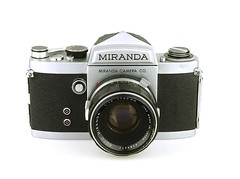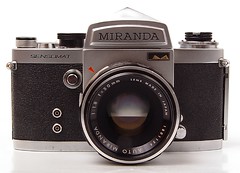Difference between revisions of "Miranda"
m (→35mm SLR) |
|||
| (43 intermediate revisions by 8 users not shown) | |||
| Line 13: | Line 13: | ||
=== Early period === | === Early period === | ||
{| class="plainlinks floatright" width=120px style="text-align: center;" | {| class="plainlinks floatright" width=120px style="text-align: center;" | ||
| − | || [http://flickr.com/photos/ | + | || [http://flickr.com/photos/camerawiki/46708080535/in/pool-camerawiki/ https://live.staticflickr.com/65535/46708080535_3c0ae9608a_t_d.jpg] |
|- | |- | ||
|| ''Ogihara Akira. {{public domain Japan new}}.'' | || ''Ogihara Akira. {{public domain Japan new}}.'' | ||
|} | |} | ||
| − | The company's founders were Ogihara Akira (萩原彰, 1920–1992<REF name="msj main"> [http://miranda | + | The company's founders were Ogihara Akira (萩原彰, 1920–1992<REF name="msj main"> [http://miranda.s32.xrea.com/miranda/index.html Main page of the Miranda Society Japan]. </REF>) and Ōtsuka Shintarō (大塚新太郎, 1921-2005<REF name="msj main" />). Ogihara studied aeronautical engineering in the Imperial University of Tokyo (later University of Tokyo) during World War II, and worked on pulse jet engines for the Japanese Navy in the University's aeronautical research center.<REF name="msj main" /> He notably developed the pulse jet engine of a manned flying bomb inspired by the German V1,<REF name="msj main" /> certainly the Ka-10 (カ10) engine for the [http://en.wikipedia.org/wiki/Kawanishi_Baika Baika] (梅花). Ōtsuka graduated from the same department one year after Ogihara, and worked on the compressor of the Ne-20 (ネ20) engine for the [http://en.wikipedia.org/wiki/Nakajima_J9Y Kikka] (橘花) jet fighter.<REF name="Hagiya 9"> Hagiya, p.9 of {{KKS}} no.64. </REF> |
When the war ended, all military research was halted in Japan, and Ogihara started a small camera workshop in a room of the former aeronautical research center.<REF name="Hagiya 9" /> He was offering repairs and modifications for professional cameras, notably making [[39mm screw lenses|Leica mount]] barrels for older lenses or military camera lenses.<REF name="Hagiya 9" /><REF name="msj main" /> At the time, Ōtsuka was working on gas turbines for civilian applications; he soon became aware of Ogihara's activities and partnered with him.<REF name="Hagiya 9" /> | When the war ended, all military research was halted in Japan, and Ogihara started a small camera workshop in a room of the former aeronautical research center.<REF name="Hagiya 9" /> He was offering repairs and modifications for professional cameras, notably making [[39mm screw lenses|Leica mount]] barrels for older lenses or military camera lenses.<REF name="Hagiya 9" /><REF name="msj main" /> At the time, Ōtsuka was working on gas turbines for civilian applications; he soon became aware of Ogihara's activities and partnered with him.<REF name="Hagiya 9" /> | ||
{| class="plainlinks floatright" width=250px style="text-align: center;" | {| class="plainlinks floatright" width=250px style="text-align: center;" | ||
| − | || [http://flickr.com/photos/ | + | || [http://flickr.com/photos/camerawiki/46708104245/in/pool-camerawiki/ https://live.staticflickr.com/65535/46708104245_9bcbc9b984_m_d.jpg] |
|- | |- | ||
|| ''Logo of Orion Seiki. Drawing by Jeffrey Felton. {{with permission}}.'' | || ''Logo of Orion Seiki. Drawing by Jeffrey Felton. {{with permission}}.'' | ||
|} | |} | ||
| − | Ogihara founded the company during the period, under the name '''Orion Seiki Sangyō Y.K.''' (オリオン精機産業<small>有限会社</small><REF name="msj main" />, meaning Orion Precision Products Industries Co., Ltd.), perhaps in 1947 — some sources say 1946 but this seems too early.<REF> The year 1946 is found in the historical section of the Miranda dx-3 user manual, p.2, [http://www.butkus.org/chinon/miranda/miranda_dx-3/miranda_dx-3.htm available in PDF format] at butkus.org. It actually seems that all the years quoted in the user manual are one year too early (see the bibliography section of this page). Other sources mentioning the same date, such as {{MK}}, p.688, might be based on that same document, see e.g. [http://www.mirandacamera.com/_modelinfo/_t/model_t.htm this page of the Miranda Historical Society] which quotes the user manual verbatim. </REF> The company was named after the constellation of Orion, because Ogihara had a special interest in astronomy.<REF name="msj main" /> Its early logo consisted of the word ''ORION'' with three stars and an arc; the three stars correspond to Orion's belt, and the arc is often associated with the figure of the mythological hunter Orion in drawing the constellation. | + | Ogihara founded the company during the period, under the name '''Orion Seiki Sangyō Y.K.''' (オリオン精機産業<small>有限会社</small><REF name="msj main" />, meaning Orion Precision Products Industries Co., Ltd.), perhaps in 1947 — some sources say 1946 but this seems too early.<REF> The year 1946 is found in the historical section of the Miranda dx-3 user manual, p.2, [http://www.butkus.org/chinon/miranda/miranda_dx-3/miranda_dx-3.htm available in PDF format] at butkus.org. It actually seems that all the years quoted in the user manual are one year too early (see the bibliography section of this page). Other sources mentioning the same date, such as {{MK}}, p.688, might be based on that same document, see e.g. [https://web.archive.org/web/20200711135527/http://www.mirandacamera.com/_modelinfo/_t/model_t.htm this page of the Miranda Historical Society] (archived) which quotes the user manual verbatim. </REF> The company was named after the constellation of Orion, because Ogihara had a special interest in astronomy.<REF name="msj main" /> Its early logo consisted of the word ''ORION'' with three stars and an arc; the three stars correspond to Orion's belt, and the arc is often associated with the figure of the mythological hunter Orion in drawing the constellation. |
The company's first product<REF name="Hagiya 9" /> was the [[Orion Coupler|Coupler]], an adapter designed by Ōtsuka<REF name="Hagiya 9" /> to use [[Contax rangefinder lenses|Contax lenses]] or [[Nikon rangefinder lenses|Nikon lenses]] on [[39mm screw lenses|Leica screw mount]] cameras while keeping the rangefinder coupling. The next products, released in the early to mid 1950s, were the [[Mirax]] reflex housings, [[Supreme lenses]] and [[Focabell]] bellows. These were first distributed by [[Summit|Summit Shōkai]], then by [[Matsushima]], managed by Mikami Makoto (三神誠). In addition to these early products, it is said that Orion Seiki worked as a subcontractor for [[Yashica|Yashima Kōgaku]] on the production of microscopes.<REF name="msj main" /> | The company's first product<REF name="Hagiya 9" /> was the [[Orion Coupler|Coupler]], an adapter designed by Ōtsuka<REF name="Hagiya 9" /> to use [[Contax rangefinder lenses|Contax lenses]] or [[Nikon rangefinder lenses|Nikon lenses]] on [[39mm screw lenses|Leica screw mount]] cameras while keeping the rangefinder coupling. The next products, released in the early to mid 1950s, were the [[Mirax]] reflex housings, [[Supreme lenses]] and [[Focabell]] bellows. These were first distributed by [[Summit|Summit Shōkai]], then by [[Matsushima]], managed by Mikami Makoto (三神誠). In addition to these early products, it is said that Orion Seiki worked as a subcontractor for [[Yashica|Yashima Kōgaku]] on the production of microscopes.<REF name="msj main" /> | ||
=== From Orion to Miranda === | === From Orion to Miranda === | ||
| − | In 1954, the company presented the Phoenix 35mm [[SLR]] prototype to the Japanese photographic press. Ogihara and Ōtsuka had been developing an SLR camera for several years, and the Phoenix was mainly developed as a promotional product to advertise their future camera.<REF name="Hagiya 10"> Hagiya, p.10 of {{KKS}} no.64. </REF> Ogihara visited various distributors to obtain funds for the development of the production camera,<REF name="Hagiya 10" /> but the only one who accepted was Mikami, who provided financial support.<REF name="Hagiya 11"> Hagiya, p.11 of {{KKS}} no.64. </REF> Orion Seiki was renamed '''Orion Camera K.K.''' (オリオンカメラ{{kabu}}) in 1955, with an equity base of 3 million yen<REF> Hagiya, p.11 of {{KKS}} no.64. The name "Orion Seiki" still appears in the advertisement by Matsushima in the June 1955 special issue of {{FAR}}, reproduced in [ | + | In 1954, the company presented the Phoenix 35mm [[SLR]] prototype to the Japanese photographic press. Ogihara and Ōtsuka had been developing an SLR camera for several years, and the Phoenix was mainly developed as a promotional product to advertise their future camera.<REF name="Hagiya 10"> Hagiya, p.10 of {{KKS}} no.64. </REF> Ogihara visited various distributors to obtain funds for the development of the production camera,<REF name="Hagiya 10" /> but the only one who accepted was Mikami, who provided financial support.<REF name="Hagiya 11"> Hagiya, p.11 of {{KKS}} no.64. </REF> Orion Seiki was renamed '''Orion Camera K.K.''' (オリオンカメラ{{kabu}}) in 1955, with an equity base of 3 million yen<REF> Hagiya, p.11 of {{KKS}} no.64. The name "Orion Seiki" still appears in the advertisement by Matsushima in the June 1955 special issue of {{FAR}}, reproduced in [https://www.flickr.com/photos/camerawiki/47674607221/in/pool-camerawiki/ this Flickr page]; an article by Ogihara in {{SK}} September 1955 shows the new name "Orion Camera K.K." </REF> (it seems that the name "Orion Camera Co." was already in use for some time as an English translation of Orion Seiki).<REF> The name "Orion Camera" or "Orion Camera Co., Ltd." is found in some original brochures or user manuals for the [[Mirax]] and [[Focabell]], certainly printed before 1955. </REF> The production SLR was released that same year and named the [[Miranda T and TII|Miranda T]], the first Japanese 35mm [[SLR]] camera commercially available with a pentaprism.<REF> {{MK}}, p.688, says 1954 for the release of the Miranda T, but this is a mistake. </REF> |
The company finally named itself '''Miranda Camera K.K.''' (ミランダカメラ{{kabu}}) after its main product in 1957.<REF> Hagiya, p.11 of {{KKS}} no.64. The first advertisement mentioning "Miranda Camera" reported in {{Kokusan}}, p.370, is in the May 1957 issue of {{ACA}}. The year 1956 found in the user manual of the Miranda dx-3, p.31, [http://www.butkus.org/chinon/miranda/miranda_dx-3/miranda_dx-3.htm available in PDF format] at butkus.org, is one year too early (see the bibliography section of this page). </REF> On the Japanese market, the early Mirandas were still distributed by [[Matsushima]] for some time, then perhaps by the company itself.<REF> The advertisement dated October 1955 reproduced in {{Kokusan}}, p.200, was placed by Matsushima whereas those dated October 1957 and February 1959 reproduced on p.306 were placed by Miranda Camera. </REF> The distribution was briefly taken over by [[Ricoh]] from early 1959, as prominently announced in early advertisements for the Miranda B.<REF> Advertisement dated March 1959 reproduced in {{Kokusan}}, p.306. Another advertisement by Ricoh, dated July 1959, is reproduced on the same page, and others are reported on p.408. </REF> It is said that this decision to join with Miranda was directly made by Ricoh's founder Ichimura Kiyoshi (市村清).<REF name="msj main" /> The agreement was however short-lived: the sales of Miranda cameras abruptly stopped in the domestic market in mid-1959 for an unknown reason,<REF name="msj main" /> and for a few years Miranda cameras were made only for export.<REF> There is a gap in the advertisements listed in {{Kokusan}}, pp.408–9, from August 1959 to September 1964. </REF> The US importer by [[Allied Impex]] (or AIC), owner of the Soligor brand, notably used on the lenses for the Miranda cameras. | The company finally named itself '''Miranda Camera K.K.''' (ミランダカメラ{{kabu}}) after its main product in 1957.<REF> Hagiya, p.11 of {{KKS}} no.64. The first advertisement mentioning "Miranda Camera" reported in {{Kokusan}}, p.370, is in the May 1957 issue of {{ACA}}. The year 1956 found in the user manual of the Miranda dx-3, p.31, [http://www.butkus.org/chinon/miranda/miranda_dx-3/miranda_dx-3.htm available in PDF format] at butkus.org, is one year too early (see the bibliography section of this page). </REF> On the Japanese market, the early Mirandas were still distributed by [[Matsushima]] for some time, then perhaps by the company itself.<REF> The advertisement dated October 1955 reproduced in {{Kokusan}}, p.200, was placed by Matsushima whereas those dated October 1957 and February 1959 reproduced on p.306 were placed by Miranda Camera. </REF> The distribution was briefly taken over by [[Ricoh]] from early 1959, as prominently announced in early advertisements for the Miranda B.<REF> Advertisement dated March 1959 reproduced in {{Kokusan}}, p.306. Another advertisement by Ricoh, dated July 1959, is reproduced on the same page, and others are reported on p.408. </REF> It is said that this decision to join with Miranda was directly made by Ricoh's founder Ichimura Kiyoshi (市村清).<REF name="msj main" /> The agreement was however short-lived: the sales of Miranda cameras abruptly stopped in the domestic market in mid-1959 for an unknown reason,<REF name="msj main" /> and for a few years Miranda cameras were made only for export.<REF> There is a gap in the advertisements listed in {{Kokusan}}, pp.408–9, from August 1959 to September 1964. </REF> The US importer by [[Allied Impex]] (or AIC), owner of the Soligor brand, notably used on the lenses for the Miranda cameras. | ||
| Line 39: | Line 39: | ||
=== Into Allied Impex === | === Into Allied Impex === | ||
| − | It is said that the Miranda company set up its own lens factory in 1963<REF name="msj main" /> (earlier lenses were supplied by various manufacturers, except for the first [[Supreme lenses|Supreme]]). The company returned to the Japanese market in autumn 1964,<REF> Advertisements listed in {{Kokusan}}, pp.408–9. </REF> but the US importer [[Allied Impex]] gradually took control, and fully owned the company by the late 1960s.<REF> [http://www.mirandacamera.com/_lenses/_soligor/soligor.htm This page of the Miranda Historical Society] says that AIC took control of Miranda in 1963, whereas the [http://miranda | + | It is said that the Miranda company set up its own lens factory in 1963<REF name="msj main" /> (earlier lenses were supplied by various manufacturers, except for the first [[Supreme lenses|Supreme]]). The company returned to the Japanese market in autumn 1964,<REF> Advertisements listed in {{Kokusan}}, pp.408–9. </REF> but the US importer [[Allied Impex]] gradually took control, and fully owned the company by the late 1960s.<REF> [https://web.archive.org/web/20200105090404/http://www.mirandacamera.com/_lenses/_soligor/soligor.htm This page of the Miranda Historical Society] (archived) says that AIC took control of Miranda in 1963, whereas the [http://miranda.s32.xrea.com/miranda/index.html Main page of the Miranda Society Japan] says that it bought all the shares in 1968 and took complete control in 1969. </REF> |
The Sensorex model was released in 1967, with TTL exposure metering. It is said that a new factory was opened outside Tokyo in 1970 or perhaps 1971.<REF> User manual of the Miranda dx-3, p.31, [http://www.butkus.org/chinon/miranda/miranda_dx-3/miranda_dx-3.htm available in PDF format] at butkus.org. The date might be one year too early (see the bibliography section of this page). </REF> In 1971, the company introduced the Sensorex EE with shutter-priority automatic exposure and a new set of viewfinders. Upgraded as the EE-2 in 1976, it would be the last Miranda with interchangeable viewfinder. | The Sensorex model was released in 1967, with TTL exposure metering. It is said that a new factory was opened outside Tokyo in 1970 or perhaps 1971.<REF> User manual of the Miranda dx-3, p.31, [http://www.butkus.org/chinon/miranda/miranda_dx-3/miranda_dx-3.htm available in PDF format] at butkus.org. The date might be one year too early (see the bibliography section of this page). </REF> In 1971, the company introduced the Sensorex EE with shutter-priority automatic exposure and a new set of viewfinders. Upgraded as the EE-2 in 1976, it would be the last Miranda with interchangeable viewfinder. | ||
| − | In 1972, the company released its only non-SLR camera, the Sensoret compact rangefinder. In 1975, it made an attempt at a compact SLR with fixed prism and electronically controlled shutter, called the Miranda dx-3. Neither of these met with great success, and the Miranda company went bankrupt on December 10, 1976<REF> [http://www.collection-appareils.fr/x/html/page_standard.php?id_appareil=594 This page at www.collection-appareils.fr]. </REF> and stopped camera production the same month.<REF> [http://www.mirandacamera.com/_modelinfo/_dx-3/dx-3.htm This page of the Miranda Historical Society]. </REF> | + | In 1972, the company released its only non-SLR camera, the Sensoret compact rangefinder. In 1975, it made an attempt at a compact SLR with fixed prism and electronically controlled shutter, called the Miranda dx-3. Neither of these met with great success, and the Miranda company went bankrupt on December 10, 1976<REF> [http://www.collection-appareils.fr/x/html/page_standard.php?id_appareil=594 This page at www.collection-appareils.fr]. </REF> and stopped camera production the same month.<REF> [https://web.archive.org/web/20200222115323/http://www.mirandacamera.com/_modelinfo/_dx-3/dx-3.htm This page of the Miranda Historical Society] (archived). </REF> |
| − | The Miranda brand was re-used in the 1980s for cheap SLR cameras (made by [[Cosina]]), lenses, flashguns or point-and-shoot cameras.<REF> [http://www.mirandacamera.com/_modelinfo/_dixons/dixons.htm This page of the Miranda Historical Society]. </REF> | + | The Miranda brand was re-used in the 1980s for cheap SLR cameras (made by [[Cosina]]), lenses, flashguns or point-and-shoot cameras.<REF> [https://web.archive.org/web/20190907231400/http://www.mirandacamera.com/_modelinfo/_dixons/dixons.htm This page of the Miranda Historical Society] (archived). </REF> |
== Serial numbers == | == Serial numbers == | ||
| − | Early products by Orion and Miranda have six-digit serial numbers. The first two look as if they might indicate the year of production, but this is misleading: they might be related to the release year of the camera model or device, but do not give a precise indication of the production year of the particular example.<REF> [[Mirax]] reflex housings with ''Miranda Camera Co.'' markings, surely made after 1957, are known with 54xxxx serial numbers (see [[Mirax]]). </REF> | + | Early products by Orion and Miranda have six-digit serial numbers. The first two look as if they might indicate the year of production, but this is misleading: they might be related to the release year of the camera model or device, but do not give a precise indication of the production year of the particular example.<REF> [[Mirax]] reflex housings with ''Miranda Camera Co.'' markings, surely made after 1957, are known with 54xxxx serial numbers (see [[Mirax]]). </REF> Based on the serial numbers, there is an assessment of the numbers produced of the different Miranda SLR groups. According to this, Miranda produced a total of about 865,000 (+/- 15%) units <ref>[http://knippsen.blogspot.com/2014/07/japanese-slr-production-numbers-part-5.html Miranda SLR production assessment] on [http://knippsen.blogspot.com KniPPsen]. </ref>. |
== Camera list == | == Camera list == | ||
=== Cameras made by Orion or Miranda Camera === | === Cameras made by Orion or Miranda Camera === | ||
==== 35mm SLR ==== | ==== 35mm SLR ==== | ||
| − | + | {|class=floatright | |
| + | || | ||
| + | {{Flickr_image | ||
| + | |image_source= https://flic.kr/p/2kpA5Hr | ||
| + | |image= https://live.staticflickr.com/65535/50806400211_ae585a9a19_m.jpg | ||
| + | |image_align= | ||
| + | |image_text= '''Miranda F''' | ||
| + | |image_by= Christoph Batz | ||
| + | |image_rights= cc | ||
| + | }} | ||
| + | |- | ||
| + | || | ||
{{Flickr_image | {{Flickr_image | ||
|image_source= http://www.flickr.com/photos/martintaylor/45836808/in/pool-camerawiki/ | |image_source= http://www.flickr.com/photos/martintaylor/45836808/in/pool-camerawiki/ | ||
|image= http://static.flickr.com/26/45836808_32d5dfc10e_m.jpg | |image= http://static.flickr.com/26/45836808_32d5dfc10e_m.jpg | ||
|image_align= right | |image_align= right | ||
| − | |image_text= Sensomat | + | |image_text= '''Sensomat''' |
|image_by= Martin Taylor | |image_by= Martin Taylor | ||
|image_rights= non-commercial | |image_rights= non-commercial | ||
}} | }} | ||
| + | |} | ||
| + | '''Knob Winders''' | ||
| + | * Miranda S | ||
| + | * Miranda ST | ||
| + | * [[Miranda T and TII]] (including the early versions marked "Orion Camera Co.") | ||
| + | '''Lever Winders''' | ||
* [[Miranda A]] | * [[Miranda A]] | ||
* Miranda AII | * Miranda AII | ||
| + | * [[Miranda B|Miranda B, C]] | ||
| + | * [[Miranda D]] (angled body, then rounded body) | ||
| + | * [[Miranda D|Miranda DR]] | ||
| + | '''Automex''' | ||
* [[Miranda Automex, Automex II|Miranda Automex]] | * [[Miranda Automex, Automex II|Miranda Automex]] | ||
* [[Miranda Automex, Automex II|Miranda Automex II]] | * [[Miranda Automex, Automex II|Miranda Automex II]] | ||
* [[Miranda Automex III]] | * [[Miranda Automex III]] | ||
| − | + | '''Modern Lever Winders''' | |
| − | * [[Miranda | + | * [[Miranda F]] (two models) |
| − | * [[Miranda | + | * [[Miranda F|Miranda FM]] |
| − | + | * [[Miranda Fv|Miranda Fv/FvT]] | |
| − | + | * [[Miranda G|Miranda G/GT]] | |
| − | + | '''Sensomat''' | |
| − | |||
| − | |||
| − | * [[Miranda Fv|Miranda FvT]] | ||
| − | * [[Miranda G | ||
| − | |||
| − | |||
| − | |||
* [[Miranda Sensomat]] | * [[Miranda Sensomat]] | ||
* Miranda Sensomat RE | * Miranda Sensomat RE | ||
| − | |||
* Miranda Sensomat RS | * Miranda Sensomat RS | ||
| + | * [[Miranda RE-II]] (this camera combined features of the Sensormat and Sensorex series) | ||
| + | '''Sensorex''' | ||
* [[Miranda Sensorex]] | * [[Miranda Sensorex]] | ||
| − | * Miranda Sensorex C | + | * [[Miranda Sensorex|Miranda Sensorex C]] |
* [[Miranda Sensorex II]] | * [[Miranda Sensorex II]] | ||
* [[Miranda Sensorex EE]] | * [[Miranda Sensorex EE]] | ||
| − | * Miranda | + | * [[Miranda EE-2]] |
| − | * [[Miranda | + | * [[Miranda RE-II]] (this camera combined features of the Sensormat and Sensorex series) |
| + | '''dx''' | ||
| + | * [[Miranda dx-3]] | ||
'''M42 mount''' | '''M42 mount''' | ||
| − | |||
| − | |||
* [[Miranda TM|Miranda TM]] | * [[Miranda TM|Miranda TM]] | ||
| + | * [[Miranda TM|Pallas TM]] | ||
* [[Soligor TM]] | * [[Soligor TM]] | ||
| − | * Soligor TM II | + | * [[Soligor TM|Miranda/Pallas/Soligor TM-II]] |
'''Scientific''' | '''Scientific''' | ||
* Mirax Laborec | * Mirax Laborec | ||
| Line 109: | Line 125: | ||
|image_text= Miranda Sensoret | |image_text= Miranda Sensoret | ||
|image_by= Alf Sigaro | |image_by= Alf Sigaro | ||
| − | |image_rights= | + | |image_rights= nc |
}} | }} | ||
* [[Miranda Sensoret]] / Soligor Sensoret | * [[Miranda Sensoret]] / Soligor Sensoret | ||
| Line 115: | Line 131: | ||
=== Cameras made by other companies === | === Cameras made by other companies === | ||
==== 35mm SLR ==== | ==== 35mm SLR ==== | ||
| − | * Miranda MS-1 | + | * [[Miranda MS-1]] |
| − | * Miranda MS-2 | + | * [[Miranda MS-1 Super]] |
| − | * Miranda MS-3 | + | * [[Miranda MS-1N]] |
| + | * [[Miranda MS-2 Super]] <!--Was there ever a non-Super MS-2?--> | ||
| + | * [[Miranda MS-3]] | ||
* Miranda Memoflex | * Miranda Memoflex | ||
==== 35mm point and shoot ==== | ==== 35mm point and shoot ==== | ||
| + | * [[Halina Micro 35 | Miranda 35ME]] | ||
* Miranda 35AF (similar to Konica 35AF) | * Miranda 35AF (similar to Konica 35AF) | ||
* Miranda A-X | * Miranda A-X | ||
| − | * Miranda FG-Z | + | * [[Halina 160 | Miranda FG-Z]] |
| + | * [[Revue_M35_Motordrive|Miranda M35 Motordrive]] | ||
* Miranda MDS-1 | * Miranda MDS-1 | ||
| + | * Miranda P700 | ||
* [[Miranda Sharp Shooter]] | * [[Miranda Sharp Shooter]] | ||
* Miranda Solo Twin | * Miranda Solo Twin | ||
| Line 133: | Line 154: | ||
== Other products by Orion or Miranda Camera == | == Other products by Orion or Miranda Camera == | ||
| − | <div class="plainlinks floatright" style="text-align: center;">[http://flickr.com/photos/ | + | <div class="plainlinks floatright" style="text-align: center;">[http://flickr.com/photos/camerawiki/33749724468/in/pool-camerawiki/ https://live.staticflickr.com/65535/33749724468_59b247357d_t_d.jpg]<br>''{{with permission}}''</div> |
* [[Mirax]] reflex housing, and Mirroscope and Mirabox name variants | * [[Mirax]] reflex housing, and Mirroscope and Mirabox name variants | ||
* [[Focabell]] bellows system | * [[Focabell]] bellows system | ||
| Line 155: | Line 176: | ||
{| class="plainlinks" align="center" style="text-align: center;" | {| class="plainlinks" align="center" style="text-align: center;" | ||
| − | || [http://flickr.com/photos/ | + | || [http://flickr.com/photos/camerawiki/47613427592/in/pool-camerawiki/ https://live.staticflickr.com/65535/47613427592_4b6f069a38_m_d.jpg] [http://flickr.com/photos/camerawiki/47613447412/in/pool-camerawiki/ https://live.staticflickr.com/65535/47613447412_101b137c06_m_d.jpg] |
|- | |- | ||
| − | || [http://flickr.com/photos/ | + | || [http://flickr.com/photos/camerawiki/46753697175/in/pool-camerawiki/ https://live.staticflickr.com/65535/46753697175_1ef3da794d_m_d.jpg] [http://flickr.com/photos/camerawiki/47616670122/in/pool-camerawiki/ https://live.staticflickr.com/65535/47616670122_420a285422_m_d.jpg] |
|- | |- | ||
|| ''Brochure for the Mirax, [[Focabell]] and [[Supreme lenses|Supreme]], c.1953, Japanese language.<br>Scans by Jeffrey Felton. {{public domain Japan new}}'' | || ''Brochure for the Mirax, [[Focabell]] and [[Supreme lenses|Supreme]], c.1953, Japanese language.<br>Scans by Jeffrey Felton. {{public domain Japan new}}'' | ||
| Line 184: | Line 205: | ||
== Links == | == Links == | ||
In English: | In English: | ||
| − | * [ | + | * [https://web.archive.org/web/20200918225642/https://www.mirandacamera.com/ Miranda Historical Society] (archived) |
| − | + | * [http://www.butkus.org/chinon/miranda.htm Miranda instruction manuals], in PDF format, some in color, at [http://www.butkus.org/chinon/ orphancameras.com] | |
| − | * [http://www.butkus.org/chinon/miranda.htm Miranda instruction manuals], in PDF | ||
* [http://web.archive.org/web/20100927204941/http://www.sillypages.com/articles/miranda-models.html Chronology of Miranda Camera Models] - useful listing of Miranda camera via [http://web.archive.org/ Internet Archive Wayback Machine] | * [http://web.archive.org/web/20100927204941/http://www.sillypages.com/articles/miranda-models.html Chronology of Miranda Camera Models] - useful listing of Miranda camera via [http://web.archive.org/ Internet Archive Wayback Machine] | ||
| − | + | * [https://cameracollector.net/miranda-camera-family/ Miranda Camera detailed list] at [https://cameracollector.net/ cameracollector.net] | |
| − | * [ | + | |
In Japanese: | In Japanese: | ||
| − | * [http://miranda | + | * [http://miranda.s32.xrea.com/ Miranda Society Japan] |
| − | * [ | + | * [https://www.hayatacamera.co.jp/monthlyphoto/200502/ Miranda T and Zunow lens] at [http://www.hayatacamera.co.jp/index.html Hayata Camera Laboratory] |
| − | |||
[[Category: Miranda|*]] | [[Category: Miranda|*]] | ||
[[Category: Japanese camera makers]] | [[Category: Japanese camera makers]] | ||
Latest revision as of 11:40, 13 March 2024
Miranda was a Japanese company that made a long line of 35mm SLR cameras.

|
| Miranda Model A image by Pete Naylor (Image rights) |
Contents
History
Early period

|
| Ogihara Akira. (Image rights). |
The company's founders were Ogihara Akira (萩原彰, 1920–1992[1]) and Ōtsuka Shintarō (大塚新太郎, 1921-2005[1]). Ogihara studied aeronautical engineering in the Imperial University of Tokyo (later University of Tokyo) during World War II, and worked on pulse jet engines for the Japanese Navy in the University's aeronautical research center.[1] He notably developed the pulse jet engine of a manned flying bomb inspired by the German V1,[1] certainly the Ka-10 (カ10) engine for the Baika (梅花). Ōtsuka graduated from the same department one year after Ogihara, and worked on the compressor of the Ne-20 (ネ20) engine for the Kikka (橘花) jet fighter.[2]
When the war ended, all military research was halted in Japan, and Ogihara started a small camera workshop in a room of the former aeronautical research center.[2] He was offering repairs and modifications for professional cameras, notably making Leica mount barrels for older lenses or military camera lenses.[2][1] At the time, Ōtsuka was working on gas turbines for civilian applications; he soon became aware of Ogihara's activities and partnered with him.[2]

|
| Logo of Orion Seiki. Drawing by Jeffrey Felton. (Image rights). |
Ogihara founded the company during the period, under the name Orion Seiki Sangyō Y.K. (オリオン精機産業有限会社[1], meaning Orion Precision Products Industries Co., Ltd.), perhaps in 1947 — some sources say 1946 but this seems too early.[3] The company was named after the constellation of Orion, because Ogihara had a special interest in astronomy.[1] Its early logo consisted of the word ORION with three stars and an arc; the three stars correspond to Orion's belt, and the arc is often associated with the figure of the mythological hunter Orion in drawing the constellation.
The company's first product[2] was the Coupler, an adapter designed by Ōtsuka[2] to use Contax lenses or Nikon lenses on Leica screw mount cameras while keeping the rangefinder coupling. The next products, released in the early to mid 1950s, were the Mirax reflex housings, Supreme lenses and Focabell bellows. These were first distributed by Summit Shōkai, then by Matsushima, managed by Mikami Makoto (三神誠). In addition to these early products, it is said that Orion Seiki worked as a subcontractor for Yashima Kōgaku on the production of microscopes.[1]
From Orion to Miranda
In 1954, the company presented the Phoenix 35mm SLR prototype to the Japanese photographic press. Ogihara and Ōtsuka had been developing an SLR camera for several years, and the Phoenix was mainly developed as a promotional product to advertise their future camera.[4] Ogihara visited various distributors to obtain funds for the development of the production camera,[4] but the only one who accepted was Mikami, who provided financial support.[5] Orion Seiki was renamed Orion Camera K.K. (オリオンカメラ㈱) in 1955, with an equity base of 3 million yen[6] (it seems that the name "Orion Camera Co." was already in use for some time as an English translation of Orion Seiki).[7] The production SLR was released that same year and named the Miranda T, the first Japanese 35mm SLR camera commercially available with a pentaprism.[8]
The company finally named itself Miranda Camera K.K. (ミランダカメラ㈱) after its main product in 1957.[9] On the Japanese market, the early Mirandas were still distributed by Matsushima for some time, then perhaps by the company itself.[10] The distribution was briefly taken over by Ricoh from early 1959, as prominently announced in early advertisements for the Miranda B.[11] It is said that this decision to join with Miranda was directly made by Ricoh's founder Ichimura Kiyoshi (市村清).[1] The agreement was however short-lived: the sales of Miranda cameras abruptly stopped in the domestic market in mid-1959 for an unknown reason,[1] and for a few years Miranda cameras were made only for export.[12] The US importer by Allied Impex (or AIC), owner of the Soligor brand, notably used on the lenses for the Miranda cameras.
In 1960, the company dropped the original dodecagonal body for a rounded body on the late-model Miranda D. It also released the Automex, with a built-in external selenium meter, and new lenses with internal diaphragm actuation and a cam transmitting the aperture setting to the body for meter coupling.
Into Allied Impex
It is said that the Miranda company set up its own lens factory in 1963[1] (earlier lenses were supplied by various manufacturers, except for the first Supreme). The company returned to the Japanese market in autumn 1964,[13] but the US importer Allied Impex gradually took control, and fully owned the company by the late 1960s.[14]
The Sensorex model was released in 1967, with TTL exposure metering. It is said that a new factory was opened outside Tokyo in 1970 or perhaps 1971.[15] In 1971, the company introduced the Sensorex EE with shutter-priority automatic exposure and a new set of viewfinders. Upgraded as the EE-2 in 1976, it would be the last Miranda with interchangeable viewfinder.
In 1972, the company released its only non-SLR camera, the Sensoret compact rangefinder. In 1975, it made an attempt at a compact SLR with fixed prism and electronically controlled shutter, called the Miranda dx-3. Neither of these met with great success, and the Miranda company went bankrupt on December 10, 1976[16] and stopped camera production the same month.[17]
The Miranda brand was re-used in the 1980s for cheap SLR cameras (made by Cosina), lenses, flashguns or point-and-shoot cameras.[18]
Serial numbers
Early products by Orion and Miranda have six-digit serial numbers. The first two look as if they might indicate the year of production, but this is misleading: they might be related to the release year of the camera model or device, but do not give a precise indication of the production year of the particular example.[19] Based on the serial numbers, there is an assessment of the numbers produced of the different Miranda SLR groups. According to this, Miranda produced a total of about 865,000 (+/- 15%) units [20].
Camera list
Cameras made by Orion or Miranda Camera
35mm SLR
| ||
|
Knob Winders
- Miranda S
- Miranda ST
- Miranda T and TII (including the early versions marked "Orion Camera Co.")
Lever Winders
- Miranda A
- Miranda AII
- Miranda B, C
- Miranda D (angled body, then rounded body)
- Miranda DR
Automex
Modern Lever Winders
- Miranda F (two models)
- Miranda FM
- Miranda Fv/FvT
- Miranda G/GT
Sensomat
- Miranda Sensomat
- Miranda Sensomat RE
- Miranda Sensomat RS
- Miranda RE-II (this camera combined features of the Sensormat and Sensorex series)
Sensorex
- Miranda Sensorex
- Miranda Sensorex C
- Miranda Sensorex II
- Miranda Sensorex EE
- Miranda EE-2
- Miranda RE-II (this camera combined features of the Sensormat and Sensorex series)
dx
M42 mount
Scientific
- Mirax Laborec
- Mirax Laborec II
- Mirax Laborec III
- Mirax Laborec Electro-D
35mm rangefinder
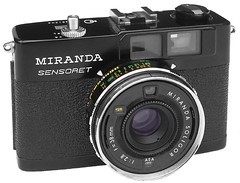
|
| Miranda Sensoret image by Alf Sigaro (Image rights) |
- Miranda Sensoret / Soligor Sensoret
Cameras made by other companies
35mm SLR
- Miranda MS-1
- Miranda MS-1 Super
- Miranda MS-1N
- Miranda MS-2 Super
- Miranda MS-3
- Miranda Memoflex
35mm point and shoot
- Miranda 35ME
- Miranda 35AF (similar to Konica 35AF)
- Miranda A-X
- Miranda FG-Z
- Miranda M35 Motordrive
- Miranda MDS-1
- Miranda P700
- Miranda Sharp Shooter
- Miranda Solo Twin
- Miranda TL 200
6×6cm folder
The Orion Six was made in the second half of the 1950s by a company called Orion Seiki, perhaps a successor of Kyōwa Kōki. This company was probably not related to Miranda's predecessor, but perhaps adopted the Orion name to draw on the good reputation of Orion/Miranda products.
Other products by Orion or Miranda Camera
- Mirax reflex housing, and Mirroscope and Mirabox name variants
- Focabell bellows system
- Supreme lenses
- Supreme and Cine-Noctar cine lenses: see Supreme lenses
- Orion Coupler, to adapt Contax or Nikon lenses on Leica screw mount cameras
- other Orion adapters:
- various lenses to 44mm screw mount, for the Mirax, Focabell or SLR cameras: see Mirax
- 44mm screw mount to Exakta or Visoflex: see Mirax
- various lenses to Miranda bayonet
- Leica screw lenses to C-mount cine cameras (c.1955–8, ¥750);[21][22]
- Leica screw lenses to D-mount cine cameras (c.1955–8, ¥1,000);[21][22]
- Leica screw lenses to Filmo 127 and 134 cine cameras (c.1958);[22]
- other Orion accessories:
- microscope adapter for Mirax or Miranda (¥3,500 in 1955);[21]
- microscope adapter for Exakta (¥5,000 in 1955);[21]
- extension tubes for Mirax or Miranda (¥2,000 in 1955);[21][23]
- extension tubes for Exakta (set of five, ¥5,850 in 1955);[21][23]
- adjustable extension tube for Leica (from 40mm to 59mm);[24]
- tester for C-mount or D-mount lenses, for use with both eyes (c.1953).[25]
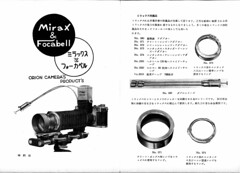 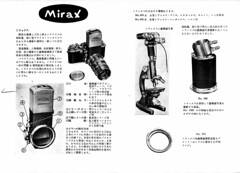
|
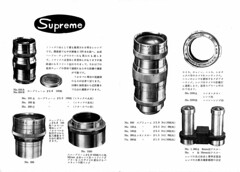 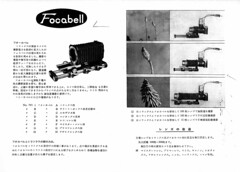
|
| Brochure for the Mirax, Focabell and Supreme, c.1953, Japanese language. Scans by Jeffrey Felton. (Image rights) |
Notes
- ↑ 1.00 1.01 1.02 1.03 1.04 1.05 1.06 1.07 1.08 1.09 1.10 Main page of the Miranda Society Japan.
- ↑ 2.0 2.1 2.2 2.3 2.4 2.5 Hagiya, p.9 of Kurashikku Kamera Senka no.64.
- ↑ The year 1946 is found in the historical section of the Miranda dx-3 user manual, p.2, available in PDF format at butkus.org. It actually seems that all the years quoted in the user manual are one year too early (see the bibliography section of this page). Other sources mentioning the same date, such as McKeown, p.688, might be based on that same document, see e.g. this page of the Miranda Historical Society (archived) which quotes the user manual verbatim.
- ↑ 4.0 4.1 Hagiya, p.10 of Kurashikku Kamera Senka no.64.
- ↑ Hagiya, p.11 of Kurashikku Kamera Senka no.64.
- ↑ Hagiya, p.11 of Kurashikku Kamera Senka no.64. The name "Orion Seiki" still appears in the advertisement by Matsushima in the June 1955 special issue of Photo Art, reproduced in this Flickr page; an article by Ogihara in Shashin Kōgyō September 1955 shows the new name "Orion Camera K.K."
- ↑ The name "Orion Camera" or "Orion Camera Co., Ltd." is found in some original brochures or user manuals for the Mirax and Focabell, certainly printed before 1955.
- ↑ McKeown, p.688, says 1954 for the release of the Miranda T, but this is a mistake.
- ↑ Hagiya, p.11 of Kurashikku Kamera Senka no.64. The first advertisement mentioning "Miranda Camera" reported in Kokusan kamera no rekishi, p.370, is in the May 1957 issue of Asahi Camera. The year 1956 found in the user manual of the Miranda dx-3, p.31, available in PDF format at butkus.org, is one year too early (see the bibliography section of this page).
- ↑ The advertisement dated October 1955 reproduced in Kokusan kamera no rekishi, p.200, was placed by Matsushima whereas those dated October 1957 and February 1959 reproduced on p.306 were placed by Miranda Camera.
- ↑ Advertisement dated March 1959 reproduced in Kokusan kamera no rekishi, p.306. Another advertisement by Ricoh, dated July 1959, is reproduced on the same page, and others are reported on p.408.
- ↑ There is a gap in the advertisements listed in Kokusan kamera no rekishi, pp.408–9, from August 1959 to September 1964.
- ↑ Advertisements listed in Kokusan kamera no rekishi, pp.408–9.
- ↑ This page of the Miranda Historical Society (archived) says that AIC took control of Miranda in 1963, whereas the Main page of the Miranda Society Japan says that it bought all the shares in 1968 and took complete control in 1969.
- ↑ User manual of the Miranda dx-3, p.31, available in PDF format at butkus.org. The date might be one year too early (see the bibliography section of this page).
- ↑ This page at www.collection-appareils.fr.
- ↑ This page of the Miranda Historical Society (archived).
- ↑ This page of the Miranda Historical Society (archived).
- ↑ Mirax reflex housings with Miranda Camera Co. markings, surely made after 1957, are known with 54xxxx serial numbers (see Mirax).
- ↑ Miranda SLR production assessment on KniPPsen.
- ↑ 21.0 21.1 21.2 21.3 21.4 21.5 Advertisement in the June 1955 special issue of Photo Art, p.22.
- ↑ 22.0 22.1 22.2 Advertisement in Shashin Kōgyō April 1958, p.317.
- ↑ 23.0 23.1 Price list in the June 1955 special issue of Photo Art, p.119.
- ↑ Device reported by Jeffrey Felton.
- ↑ Brochure Mirax & Focabell, Orion Camera's Product's.
Bibliography
- Hagiya Takeshi (萩谷剛). "Miranda Sutōrī" (ミランダ・ストーリー, Miranda story). In Kamera Rebyū: Kurashikku Kamera Senka (カメラレビュー クラシックカメラ専科) / Camera Review: All about Historical Cameras no.64, June 2002. ISBN 4-257-13048-2. Miranda no keifu (ミランダの系譜, Miranda genealogy). Pp.9–12.
- McKeown, James M. and Joan C. McKeown's Price Guide to Antique and Classic Cameras, 12th Edition, 2005-2006. USA, Centennial Photo Service, 2004. ISBN 0-931838-40-1 (hardcover). ISBN 0-931838-41-X (softcover).
- Miranda Camera Co., Ltd. Owner's manual of the Miranda dx-3. Contains a short history of the company on pp.2 and 31. Available in PDF format at butkus.org.
- It seems that all the years quoted in this user manual are one year too early, perhaps because of a mistake in the translation of the Japanese Shōwa year:
- 1953 instead of 1954 for the Phoenix;
- 1954 instead of 1955 for the Miranda T;
- 1957 instead of 1958 for the Miranda A, A2 and B;
- 1959 instead of 1960 for the Automex;
- 1970 instead of 1971 for the Sensorex EE.
- All the other dates mentioned in this document should therefore be handled with caution.
- Orion Camera. Mirax & Focabell, Orion Camera's Product's. (ミラックスとフォーカベル, Orion Camera's product's.) Brochure in Japanese language, c.1953.
- Photo Art rinji zōkan: Kamera akusesarī zensho (フォトアート臨時増刊・カメラアクセサリー全書, Photo Art special issue: All the camera accessories). June 1955, no.80 of the magazine.
- Advertisement by the photo department of Matsushima Megane-ten on p.22.
- "Shashin no kaimi wa sessha to bōen satsuei kara: Purokusā, Ōtoappu, Refubokkusu, sonota." (写真の快味は接写と望遠撮影から・プロクサー・オートアップ・レフボックス・その他, Because the appeal of photography comes with close-up and telephoto pictures: Proxar, Auto-Up, reflex housing, etc.) Pp.118–20.
- Shashin Kōgyō no.72, April 1958. Advertisement by Matsushima Shashin-yōhin on p.317.
Links
In English:
- Miranda Historical Society (archived)
- Miranda instruction manuals, in PDF format, some in color, at orphancameras.com
- Chronology of Miranda Camera Models - useful listing of Miranda camera via Internet Archive Wayback Machine
- Miranda Camera detailed list at cameracollector.net
In Japanese:
